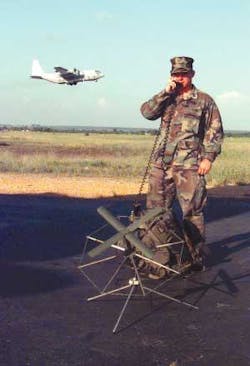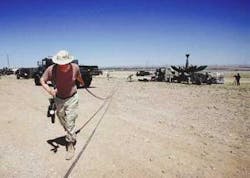By J.R. Wilson
Washington — A new decade in a new millennium, but war in Iraq has again provided the U.S. military with an opportunity to test new equipment, tactics, and technologies under fire and record a significant list of lessons learned.
Just as the first Persian Gulf War in 1991 validated such then-new technologies as unmanned aerial vehicles (UAVs), precision-guided munitions, and enhanced communications capabilities, the second Persian Gulf War in 2003 (Gulf War II) has done the same for the next generation of those as well as new technologies in battlefield medicine, target acquisition, and the use of satellites.
Many of these were doctrinal or structural such as a Gulf War II reorganization of the Marine Force Service Support Group (FSFG) that enabled logistics to keep up with fast-moving combat forces, and the creation (also new for Gulf War II) of en-route care capability — nurses who stayed with the most critical patients from initial treatment by a Forward Resuscitative Surgery System (FRSS) to handover at a higher echelon medical facility at the rear.
Satellite communications were more important than ever for U.S. forces involved in the second Persian Gulf War of 2003.
null
Other lessons, however, involved the technology of war — some good, some not.
Medical technology
Medical care, in particular, benefited from new technologies that reduced the numbers who died from wounds. The introduction and consistent use of Kevlar helmets and flak jackets almost eliminated head and torso wounds, resulting in fewer killed instantly and an increased ability of general surgeons to save those who were wounded. Putting medical teams, such as the Marine FRSS and Army FST (Forward Surgical Team) and Shock Trauma Platoons on the front, along with more highly trained field medics, also had a major influence on getting the wounded home alive and with less risk of amputations.
Enhancing that care was the presence, close to the fight, of portable ultrasounds that enabled medical personnel to diagnose internal bleeding and collapsed lungs quickly and accurately, determine the presence of shrapnel in a wound, and generally speed up triage. Developed by SonoSite Inc. of Bothell, Wash., the 5.4-pound, all-digital, hand-carried iLook unit can boot up in less than seven seconds, using the VxWorks real-time operating system from Wind River Systems in Alameda, Calif.
Other medical advances of Gulf War II included the use of portable oxygen generators instead of heavy and volatile oxygen bottles, a rapid infusion pump for fluids, new ventilators and a digital radiology and angiogram suite to shoot vascular X-rays.
The result was "the most successful medical operation in history," says Brig. Gen. George Weightman, commander of the 3rd Medical Command and head of Gulf War II theater medical forces.
Precision-guided weapons
Precision-guided munitions played a starring role in Gulf War II, accounting for some 70 percent of all bombs and missiles that coalition forces used. Going into the war, military planners were concerned about Iraq's ability to jam the global positioning system (GPS) signals that these weapons use for guidance. As it happened, Iraqi jamming was ineffectual; jammers were destroyed quickly after they went into operation and had little influence on the overall accuracy of coalition weapons.
Even so, U.S. Department of Defense (DOD) planners are putting additional research into better anti-jamming technology for future conflicts.
As troops return from deployment to Iraq, individual soldiers are providing more input than ever into DOD's "lessons learned" analysis of what worked and what did not. In some instances, the services used Iraq to test new equipment, issuing it to only a few units to compare with what was being used more broadly. For example, some units were issued new Northrop Grumman AN/PVS-14 night-vision goggles and recommended them as a replacement for the standard PVS-7 for comfort and performance.
Not every such change came from the military, however. The commercial world and soldier ingenuity also showed where DOD might look for future combat technologies. For example, some soldiers were reported to have purchased civilian hand-held laser pointers to use in orienting fire from more than one platform weapon.
One of the big jobs of recent military operations was setting up enough satellite antennas to satisfy demand for communications bandwidth.
null
The same held true for individual GPS, with many soldiers buying commercial systems rather than using the military-issued Rockwell Collins PLGR (Precision Lightweight GPS Receiver). The most popular was the Rino from Garmin Ltd. in Olathe, Kan., which the Army did issue to the 82nd Airborne as part of its Rapid Fielding Initiative (a $400 million effort to improve those things on which soldiers have been spending their own money). The Rino also has a two-way radio capability, but it was rarely used because of security concerns.
Communications concerns
Communications was one of the technologies that came under the sharpest criticism in Iraq, with some comments reminiscent of those heard after the 1983 invasion of Grenada, which prompted a wide array of research and development programs to eliminate such problems on the battlefield.
Capt. Robert Sorenson, a doctor assigned to Surgical Company Bravo that moved with the 1st Marine Expeditionary Force (I MEF), says forward medical units often found "the communications capability wasn't as good as we would have liked but we were doing a lot of moving around."
Of special concern was communications at the squad level, where some soldiers bought their own handsets and longer antennas to extend the range of the radios they were issued. That was a common complaint of dismounted squads attempting to communicate with each other, especially when operating independently in urban terrain. The Multiband Inter/Intra Team Radio (MBITR) at the company and platoon level was cited as a possible replacement for the intrasquad radio (ISR), but would need to be smaller and lighter.
In what could be an answer to that problem, on 19 May Thales Communications of Clarksburg, Md., teamed with Innovative Concepts in McLean, Va., to provide Internet protocol (IP) routing capabilities for a new Joint Tactical Radio System (JTRS)-compatible MBITR hand-held radio.
Communications during Gulf War II relied heavily on military and civilian satellites, which handled some ten times the volume of voice and data traffic of any previous war. In general, it was a success, but there were some areas that still need work, such as missile warning.
"The lesson learned was we didn't really have a fusion capability to present one picture to the operator, so we need to improve our ability to fuse multi-sensor information to create that common picture for the operator to use," says Brig. Gen. Larry James, who filled a new position as Senior Space Officer in the Combined Arms Operations Center during Gulf War II.
"The other piece of that that we did exactly right was building very robust multipath networks out to the various sites that required the warning information," James says. "That was probably the most robust missile warning system we had ever created. Satcom was critical to that, although we used microwave to reach some areas, it really depended on where we needed to go and what we needed to get good, redundant communications into those nodes."
Maj. Gen. Judd Blaisdell, director of space operations and integration for the Air Force Staff, says he predicts Iraq will provide significant lessons in how to improve the combined use of satellites and others assets in future conflicts.
"We are getting better and better at bringing the synergies of air, space, and ground forces together," Blaisdell says. "We fight jointly. That allows us to capitalize on the positives of all those systems. It also allows us to see what didn't work so well. So with communications or space-based radar or GPS and jamming, the enemy is going to have space in their operations annex. We know that. They will look for gaps and seams, just as we do. We do that in a number of exercises and will look at lessons coming out of Iraq to make those better and to look for where we have some vulnerabilities."
Another area of continuing concern is combat identification.
"If I had a single greatest disappointment in this, it would be combat identification," says I MEF operations officer Col. Larry Brown. "They were not substantially better than 12 years ago when we crossed into Iraq the first time. There still is no good IFF (identification, friend, or foe) system. We have a long way to go on that. We have to find a way to avoid blue-on-blue (fratricide, aka 'friendly fire').
"I knew where my units were, how fast they were going in terms of situational awareness, in terms of the objective, I had that information and could make decisions earlier and better. But that's not the same as combat ID, which is the Marine on the ground looking through the sights and trying to figure out if the guy he is about to shoot is an enemy or from an adjacent unit."


